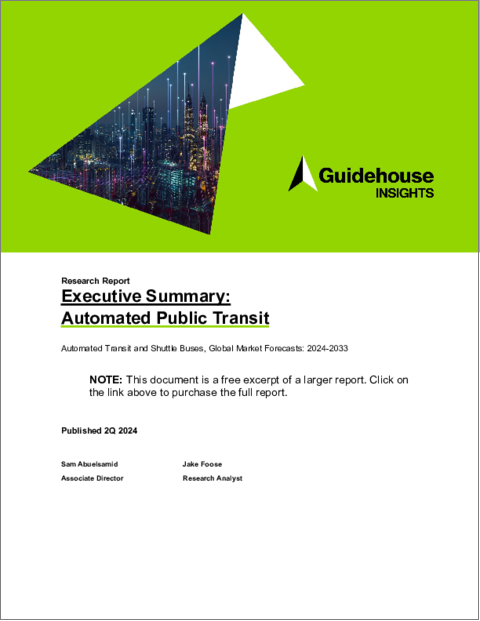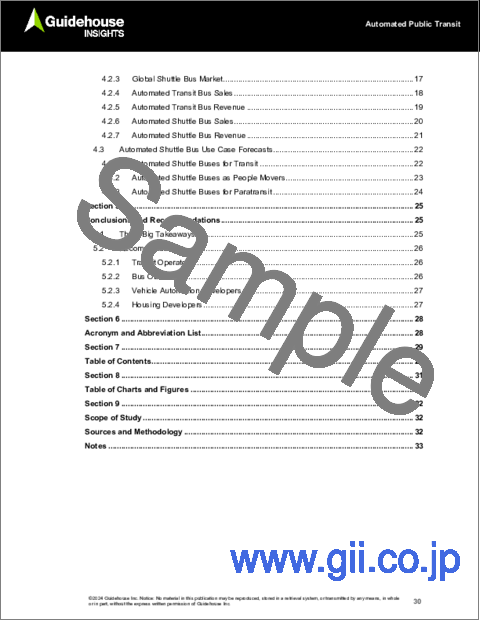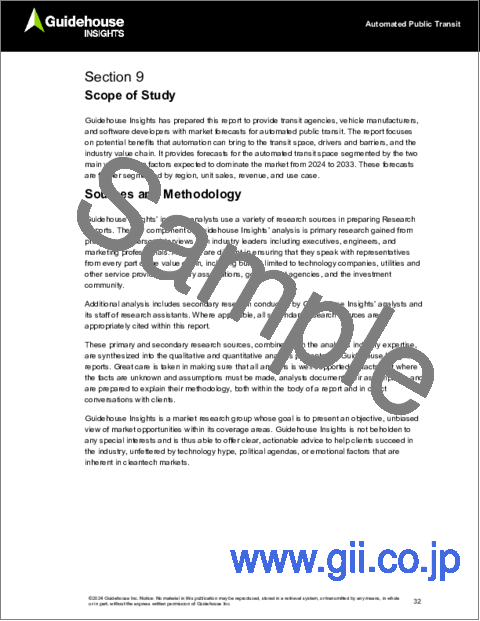|
|
市場調査レポート
商品コード
1476283
自動公共交通の世界市場 - 自動交通バスとシャトルバス、市場予測(2024年~2033年)Automated Public Transit - Automated Transit and Shuttle Buses, Global Market Forecasts, 2024-2033 |
||||||
|
|||||||
| 自動公共交通の世界市場 - 自動交通バスとシャトルバス、市場予測(2024年~2033年) |
|
出版日: 2024年05月07日
発行: Guidehouse Research
ページ情報: 英文 34 Pages; 23 Tables, Charts & Figures
納期: 即納可能
|
全表示
- 概要
- 図表
- 目次
車両の自動化は何十年もの間、開発者たちの白鯨でした。現在、完全にドライバーのいない小型車(LDV)が特定の都市や市場で普及し始めています。しかし、この技術が活用されていないのが、交通の分野です。自動化された公共交通機関は、LDVの自動化の多数の利点を提供し、さらにいくつかの利点を提供します。交通車両は運行設計領域が限られているため、車両を停止させる例外が少ないです。また、交通車両は一般的に低速ルートを走行するため、衝突時の被害が軽減されます。さらに、自動化はCOVID-19パンデミック後に交通機関が現在直面している人員配置の問題の多くを解決する可能性があり、乗客の乗車体験に注力するためにドライバーをさらに訓練することができます。
自動公共交通はまだ開発の初期段階にあり、2024年に販売される予定の自動運転車は300台強に過ぎません。しかし、その数は2033年に1万1,500台以上に増加すると予測されています。自動公共交通は、交通車両市場全体ではまだ小さなセグメントですが、今後10年間に大きな成長が見込まれます。
当レポートでは、世界の自動公共交通市場について調査し、売上と収益の予測、採用の促進要因と障壁の詳細、産業バリューチェーンの分析などを提供しています。
目次
第1章 エグゼクティブサマリー
- 市場の概要
- 範囲
- 市場予測
第2章 市場の問題
- 促進要因
- 労働力の削減
- 安全性
- コスト削減
- 限られた運行空間
- アクセス性
- 障壁
- 規則
- 料金
- 社会の認識
- 交通機関の惰性
- 価格設定
- その他のビジネス問題
第3章 産業バリューチェーン
- 競合情勢
- ビジネスモデルの進化
第4章 市場予測
- 予測手法
- 市場予測
- 世界のバス市場
- 世界の交通バス市場
- 世界のシャトルバス市場
- 自動交通バスの売上
- 自動交通バスの収益
- 自動シャトルバスの売上
- 自動シャトルバスの収益
- 自動シャトルバスのユースケースの予測
- 交通向け自動シャトルバス
- 人々の移動手段としての自動シャトルバス
- 補助的交通向け自動シャトルバス
第5章 結論・推奨
- 3つの大きなポイント
- 推奨
- 交通事業者
- バスOEM
- 車両自動化開発業者
- 住宅開発業者
第6章 頭字語と略語のリスト
第7章 目次
第8章 図表
第9章 調査範囲、情報源と調査手法、注釈
List of Tables
- Bus Sales by Region, World Markets: 2024-2033
- Transit Bus Sales by Region, World Markets: 2024-2033
- Shuttle Bus Sales by Region, World Markets: 2024-2033
- Automated Transit Vehicle Sales, World Markets: 2024-2033
- Automated Transit Bus Sales by Region, World Markets: 2024-2033
- Automated Shuttle Bus Sales by Region, World Markets: 2024-2033
- Automated Transit Bus Revenue by Region, World Markets: 2024-2033
- Automated Shuttle Bus Revenue by Region, World Markets: 2024-2033
- Automated Shuttle Buses for Transit, Sales by Region, World Markets: 2024-2033
- Automated Shuttle Buses as People Movers, Sales by Region, World Markets: 2024-2033
- Automated Shuttle Buses for Paratransit, Sales by Region, World Markets: 2024-2033
List of Figures
- Automated Transit Vehicle Sales, World Markets: 2024-2033
- Bus Sales by Region, World Markets: 2024-2033
- Transit Bus Sales by Region, World Markets: 2024-2033
- Shuttle Bus Sales by Region, World Markets: 2024-2033
- Automated Transit Bus Sales by Region, World Markets: 2024-2033
- Automated Transit Bus Revenue by Region, World Markets: 2024-2033
- Automated Shuttle Bus Sales by Region, World Markets: 2024-2033
- Automated Shuttle Bus Revenue by Region, World Markets: 2024-2033
- Automated Shuttle Buses for Transit, Sales by Region, World Markets: 2024-2033
- Automated Shuttle Buses as People Movers, Sales by Region, World Markets: 2024-2033
- Automated Shuttle Buses for Paratransit, Sales by Region, World Markets: 2024-2033
Pictorial Representation of the Industry Value Chain
Vehicle automation has been the white whale of developers for decades. Now, fully driverless light duty vehicles (LDVs) are beginning to proliferate in certain cities and markets. Where this technology has not been utilized, however, is in the transit space. Automated public transit offers many of the benefits of LDV automation and offers a few more. The limited operational design domain of transit vehicles means fewer exceptions to interrupt the vehicle. Transit vehicles also typically follow lower speed routes, reducing harm in the event of a crash. In addition, automation can potentially solve many of the staffing issues transit agencies currently face in the wake of the COVID-19 pandemic, allowing drivers to be trained more to focus on passengers' riding experience.
Automated public transit is still in the nascent stages of market development, with just over 300 hands-off, eyes-off, brain-off automated transit vehicles expected to be sold in 2024. However, that number is expected to grow to over 11,500 vehicles sold in 2033. While automated public transit is still a small segment of the overall transit vehicles market, it is expected to see significant growth over the next decade.
This Guidehouse Insights report provides automated public transit market forecasts, a deep dive into the drivers and barriers to adoption, and an industry value chain analysis. It provides sales and revenue forecasts for transit automation segmented into the two main vehicle sizes for the 10-year period from 2024-2033. These forecasts are further segmented by region and use case.
Table of Contents
1. Executive Summary
- 1.1 Market Overview
- 1.2 Scope
- 1.3 Market Forecast
2. Market Issues
- 2.1 Drivers
- 2.1.1 Workforce Reductions
- 2.1.2 Safety
- 2.1.3 Cost Savings
- 2.1.4 Limited Operating Spaces
- 2.1.5 Accessibility
- 2.2 Barriers
- 2.2.1 Regulations
- 2.2.2 Cost
- 2.2.3 Public Perception
- 2.2.4 Transit Agency Inertia
- 2.3 Pricing
- 2.4 Other Business Issues
3. Industry Value Chain
- 3.1 Competitive Landscape
- 3.1.1 Business Model Evolution
4. Market Forecasts
- 4.1 Forecast Methodology
- 4.2 Market Forecasts
- 4.2.1 Global Bus Market
- 4.2.2 Global Transit Bus Market
- 4.2.3 Global Shuttle Bus Market
- 4.2.4 Automated Transit Bus Sales
- 4.2.5 Automated Transit Bus Revenue
- 4.2.6 Automated Shuttle Bus Sales
- 4.2.7 Automated Shuttle Bus Revenue
- 4.3 Automated Shuttle Bus Use Case Forecasts
- 4.3.1 Automated Shuttle Buses for Transit
- 4.3.2 Automated Shuttle Buses as People Movers
- 4.3.3 Automated Shuttle Buses for Paratransit
5. Conclusions and Recommendations
- 5.1 Three Big Takeaways
- 5.2 Recommendations
- 5.2.1 Transit Operators
- 5.2.2 Bus OEMs
- 5.2.3 Vehicle Automation Developers
- 5.2.4 Housing Developers





